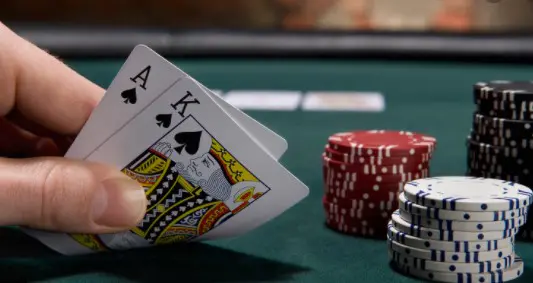Your options over time are the ultimate decider of whether you win a fortune or lose your shirt.
Standing
The participant elects to”stand” with the current total and not to draw any additional cards. When the cards are dealt face-down, you slide your cards under your chips. The dealer will understand the message. If you’re in a face-up game, wave your hand back and forth in a wiping motion just above your cards, that is the sign for standing. All casinos insist on some hand sign; verbal statements aren’t accepted. Casinos can get rather noisy, and it’s not hard for a trader to mishear a participant. Additionally, the cameras concealed in the casino ceilings may be employed to resolve disputes only if hand signs are used, as they don’t have a sound component.
Hitting
The participant elects to draw an extra card or cards. If you’re in a face-down match, then draw your cards with a quick scratching movement against the felt once or twice. In a face-up match, create a similar motion with your fingertips or, instead, point to your cards with your index finger.
Splitting.
If you have two cards with the same price, you might split them and play each as another hand. To signify a desire to break your menus, place an additional wager equivalent to the initial one to the side of it. If you’re playing in a face-down game, you have to expose your cards. After splitting a pair, several other options become available. You may resplit if a third party like-valued card appears. Or you could double back on the split hands in a suitable card to be drawn. By way of instance, if you’ve split 8’s and grab a three on the first 8, then now you can double down with this total of 11. The two resplitting and doubling and doubling down after a split is to the player’s advantage.
Doubling Down
The player may double the size of their initial wager and elect to draw just one additional card. The typical doubling situation is where you’ve got a hand that stands a chance of getting excellent writing with one extra card; for instance, your first two cards total 10 or 11. To signify that a double bet, slide another chance to the side of the initial wager. This wager might be as much as but no more than your initial bet. If you’re playing in a face-down game, you have to expose your cards. V
Insurance
Calling this”insurance” is somewhat misleading. It’s nothing aside from a side bet that’s paid at 2 to 1. If you would like to take insurance (recommended in particular circumstances familiar by a professional card counter only), put a bet equal to half your original wager in the semicircle running in front of your gaming place. If the trader has a blackjack, you’ll lose your real chance but win the insurance wager and break even on the hand. If the dealer doesn’t have blackjack, you’ll lose the insurance wager, and the writing will usually be performed.
Surrender
If your hand appears particularly unpromising against the traders’ exposed card, you have the choice of devoting half of your wager and retiring in hand. By way of instance, in case you have 9, 7 against a dealer ten and your odds of winning the hand are slim — less than.5 — and it is to your advantage to give up half of your bet. There are two forms of surrender: “overdue” and”early.” Both kinds of sacrifice are to the players’ advantage, with premature surrender being most favorable. Not all casinos allow late submission and the ones that don’t necessarily post it in the tables. Except for the occasional advertising, no casino offers early surrender any longer.
Surrender, incidentally, is the only play on the table, requiring a verbal response; there’s no hand signal. If you would like to concede your hand, say”Surrender.” The trader will remove half your wager and return the other half.
Blackjack is played at a table with one trader and from one to seven players. The layout gives a couple of basic rules, like the payoff for blackjack, insurance, and if the dealer hits on soft seventeen.
There’ll usually be a little sign to one side of the trader that provides the table bets and any special rules, like whether surrender is permitted. You have to request to find other posted regulations and regulations. You’ll have to know, by way of instance, whether doubling down after splitting is allowed, if or not a player may double down on any two cards, if pairs may be split a second time, and if aces might be resplit. Such rules determine whether the simple game is favorable or unfavorable.
Rules
The game itself is painless. You, the participant, try to collect cards with a numerical total closer to (but not more than) twenty-one than those gathered by the dealer. If you do this, you win. If the traders’ total is nearer to twenty-five yours, you lose. Winning hands are always paid fairly. In case you and the dealer both arrive at the same total, the writing is a”push,” and no one wins. Made your bet before any cards have been dealt, and no wager could be changed when the first card was dealt.
The combination of an A and any ten on the first two cards is blackjack and is an automatic winner. A player blackjack is paid at 3 to 2. After the home has a blackjack, the participant loses his wager rather than one and a half times that wager.
The player must choose if he takes additionals cards after the initial dealt based on two pieces of advice: the cards held and the dealer’s upcard. This is the moment of fun in the game. A vast array of alternatives offer themselves, and unless the participant understands the sport’s essentials, there are various ways to go wrong.


